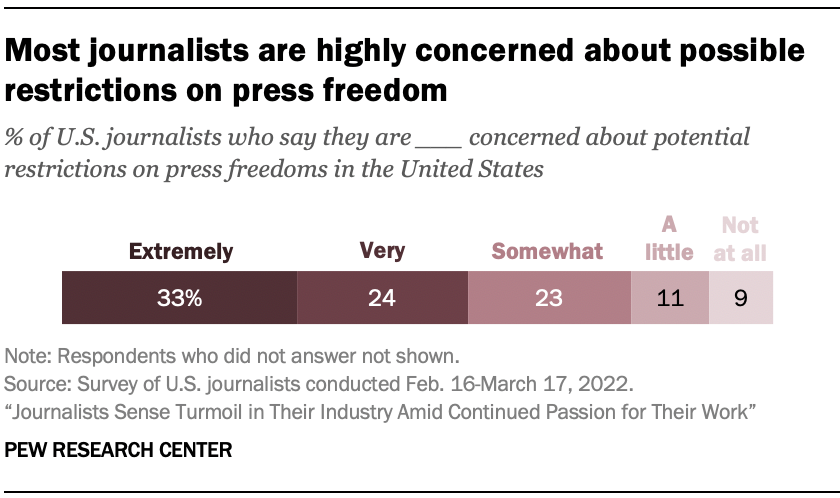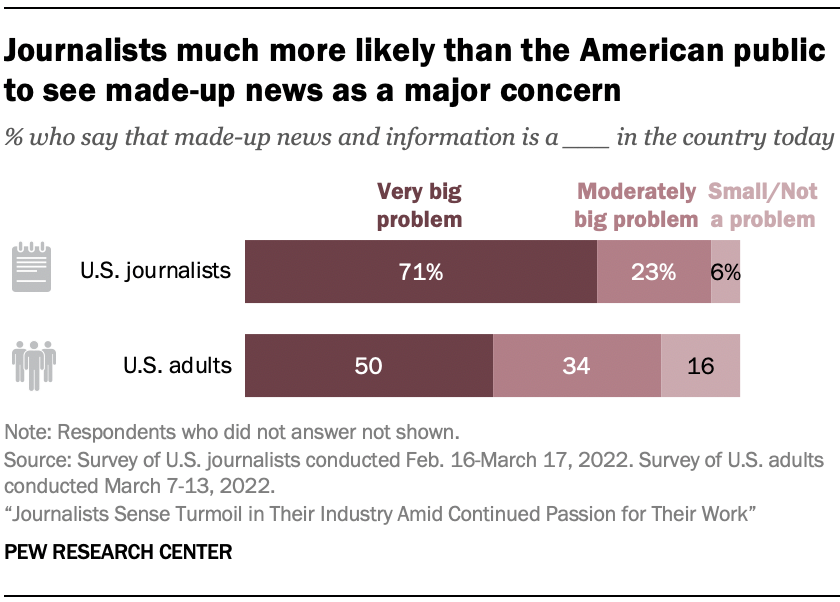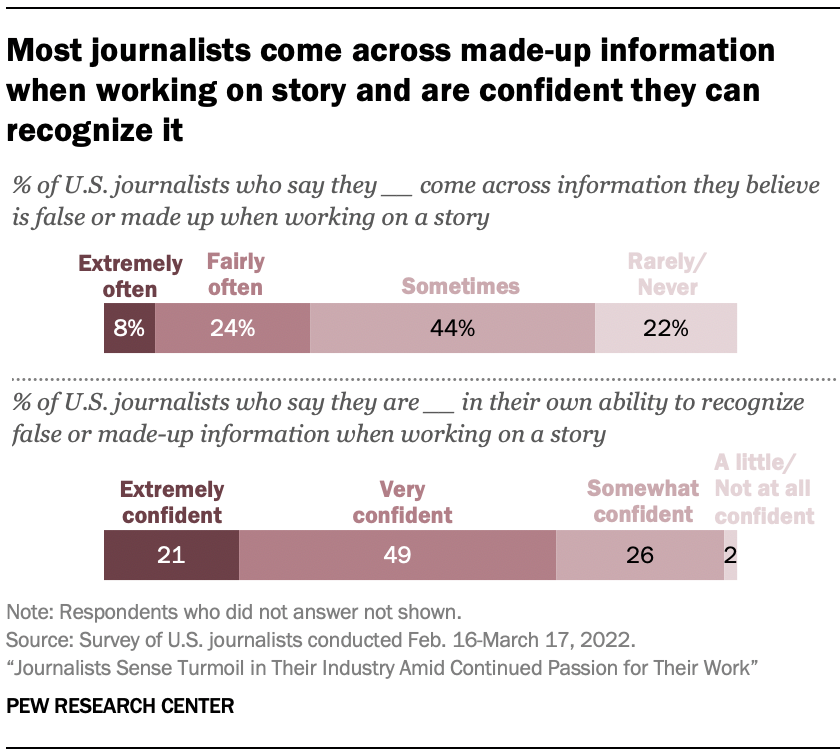Amid efforts to fight false and made-up information, anti-media campaigns, increased lawsuits and global news crackdowns, journalists in the United States express great concern about the future of press freedoms.

Roughly six-in-ten journalists surveyed say they are either extremely (33%) or very concerned (24%) about potential restrictions on press freedoms in the U.S. About a quarter (23%) are somewhat concerned, while just one-in-five express low levels of concern about this.
Journalists see false and made-up news as a big problem and don’t have much confidence in how the industry handles it

Another area of concern for journalists is the volume of erroneous information today. More than nine-in-ten journalists surveyed (94%) say made-up news and information is a significant problem in America today, with 71% identifying it as a very big problem and 23% seeing it as a moderately big problem; 6% say it is a small problem or not a problem at all.
The American public also sees made-up news and information as a problem, but not quite to the same extent. In a separate survey of 10,441 U.S. adults conducted March 7-13, 2022, 50% say made-up news is a very big problem (21 percentage points below journalists), while another 34% say it is a moderately big problem and 16% say it is a small problem or not a problem at all.
Misinformation is a fairly regular topic of conversation within the newsroom itself. About six-in-ten journalists (58%) say they had conversations with colleagues about misinformation at least several times a month over the past year.

The survey also finds that one-third of journalists indicate that they deal with false or made-up news in their work on a fairly regular basis – saying that they come across false information when working on a story either extremely often (8%) or fairly often (24%). Another 44% say they sometimes come across it.
About seven-in-ten journalists (71%) say they are either extremely (21%) or very confident (49%) in their ability to recognize false information when they are working on a story.
Still, specifically among reporting journalists, about a quarter (26%) say they unknowingly reported on a story that was later found to contain false information. (Reporting journalists are those who indicated in the survey that they report, edit or create original news stories and that they have one of the following job titles: reporter, columnist, writer, correspondent, photojournalist, video journalist, data visualization journalist, host, anchor, commentator or blogger. About three-quarters of all journalists in this study – 76% – are reporting journalists.)
While the journalists surveyed here may feel good about their own ability to detect misinformation, they are not particularly confident in the industry’s ability to manage or correct it. Only 8% of all journalists surveyed say news organizations do a very good job at handling misinformation, while another 35% say news outlets are somewhat good at it – lower than the ratings journalists give news organizations on several other core functions (see Chapter 4).
And most say their news organization (or the main one they work for if they work for more than one) does not have formal guidance on how to handle made-up and false information in their jobs. Six-in-ten say their organization does not have guidelines for how to handle false and made-up information that they come across, far higher than the 36% who say their organization does.
Most journalists think it is important to report on the false statements of public figures

Most journalists think that part of managing misinformation means reporting on public figures who make false or made-up statements. Twice as many journalists say that if a public figure makes a statement that is false or made up, news organizations should “report on the statement because it is important for the public to know about” (64%) rather than “not report on the statement because it gives attention to the falsehoods and the public figure” (32%).
Many journalists, though, never or almost never cover the issue of misinformation. Two-thirds of journalists surveyed (66%) say almost none of the stories they worked on in the past year had to do with false or made-up information. Just 6% of those surveyed say half or more of the news stories they worked on covered false or made-up news in some way, while about a quarter (27%) say that some of their stories – but fewer than half – dealt with this topic.
Vast majority of journalists are against requiring a license to be a journalist

One particular feature of journalism is that there is no requirement to have a license or certification process to call oneself a journalist – unlike a physician would in order to practice medicine in the United States. The question of whether to require one or not occasionally gets raised. As of now, a solid majority of journalists are against such a requirement. Nearly three-quarters of journalists (74%) are in favor of continuing to allow journalists to practice journalism without needing a license. One-quarter of U.S. journalists would like to see a license required for members of their industry. (Chapter 8 looks at how these views vary by the original platform of the organization that journalists work for.)
Currently, there is no licensing requirement for journalists themselves. Radio and television stations are licensed and regulated by the Federal Communications Commission, but there is no such regulatory authority for newspapers and online outlets.


 What do journalists think the news industry does best and worst?
What do journalists think the news industry does best and worst?